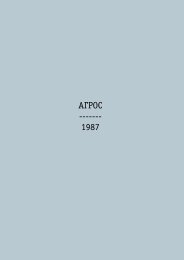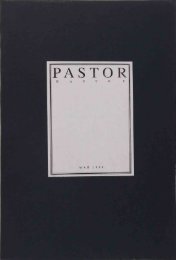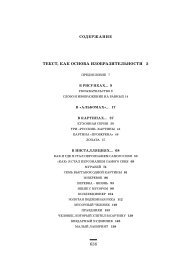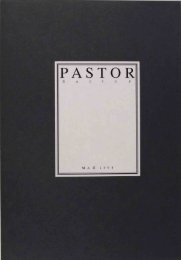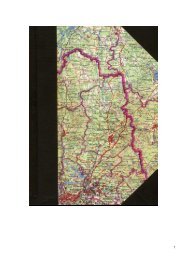А. Монастырский, Н. Панитков, И. Макаревич, Е. Елагина, С ...
А. Монастырский, Н. Панитков, И. Макаревич, Е. Елагина, С ...
А. Монастырский, Н. Панитков, И. Макаревич, Е. Елагина, С ...
You also want an ePaper? Increase the reach of your titles
YUMPU automatically turns print PDFs into web optimized ePapers that Google loves.
Slogan-2003 (with Martin Heidegger) may be a separate action, but it is deeply embedded into the<br />
common structure of two actions, namely Action with Hours and the slogan itself. It is constructed on<br />
such notions-categories as ―hiddenness‖ and ―place‖ (but not ―space‖).<br />
The last piece, Slogan-2005, was carried out here as well. It is a serial action that continues several<br />
line of CA‘s at once, and not only the line of the slogans (for instance, it continues the line of actions<br />
of The Means of the Row and On the Clearing).<br />
S.H.: On the one hand, CA‘s slogans are assimilated to the expressive forms of the surrounding sign<br />
field, but the device of serial repetition presents the spectator with another horizon of perception. The<br />
act of distancing is also connected to critical intentions. The slogan‘s banner contains a personal text.<br />
―We‖ is replaced by ―I‖ (for an example, in Slogan-77: ―I‘m not complaining about anything…‖).<br />
But in the continuation of the series through the second Slogan, the illusion of the lyrical subject is<br />
dispelled (―Why did I Lie to Myself…‖). The variations within the series redirect the audience‘s<br />
attention to the factors that supply the slogan with its form, while its content is emptied out. This<br />
already takes place in the poetic texts of CA‘s first two slogans: through paradoxical linguistic<br />
constructions in the tradition of Zen-Buddhist koans, signification actually consists in the cancellation<br />
of meaning. Yet in the third slogan ―To Georgy Kizevalter‖, which is hung up in such a way that even<br />
the letters of the text are impossible to decipher, all that remains as a relic is the outer material form, a<br />
design with no content. In the example of the actions with slogans, it becomes obvious what an<br />
important role the serial principle plays in the aesthetics of CA. Seriality questions the conventional<br />
notion of the artwork, which is usually defined by the clear-cut boundaries of a separate thing.<br />
Repetitive structures refer to the age-old traditions of ritual culture, in which reiteration effects the<br />
self-affirmation of commonality as well as a sense of satisfaction at recognizing that which is<br />
expected. But on the other hand, in the traditions of poetry or music, variations of repetitive<br />
structures do not only affirm the expected, but also create an aesthetic sensibility for the most<br />
minimal of changes in the series‘ development. This gives rise to the possibility for perceiving almost<br />
indiscernible nuances in the formative process. HOW everything repeats becomes more important<br />
than WHAT is being repeated. Through its endless textuality, the serial system of CA continues to<br />
generate new actions and new ―eventness.‖ What is the relationship between the text machine of CA<br />
and the immediate perception of ―eventness‖ in its actions<br />
A.M.: This question is very important. Text generates eventness. In the beginning of the series,<br />
―eventness‖ is generated through some ―hidden‖, ―alien‖ text (explicit or implicit imitations based on<br />
the assumption that any aesthetic ―eventness‖ whatsoever arises from text). But as the series develops<br />
and in the course of CA‘s ongoing praxis over the duration of many years, we have quite a profound<br />
development: what arises is a ―narrow‖ path of sorts, a footpath (in contrast to the initial field roads,<br />
barely visible or rutted). The aesthetic placements of new articulations are joined onto those that<br />
preceded them. From the field to the field path, as it were. The first slogans took place on open fields,<br />
while the last two were executed in a rather narrow clearing in the forest with a footpath leading up to<br />
it. In the first case, we are dealing with space and with horizons, while in the second case, we are<br />
dealing with place and verticality (the forest). The ―field‖ slogans with indefinite aesthetic ―edges‖<br />
interact well with their exterior contexts and even dissolve into them (―poles of indistinction‖). The<br />
―foot path‖ slogans, however, have their own rigid aesthetic carcass, and are separated from exterior<br />
contexts, through historicity, among other things, through Heidegger‘s portrait or the Diamond Sutra<br />
(instead of the ―currency‖ of the financial billboard or the existential state ―here and now‖). From an<br />
expositional point of view, the early slogans are derivative and secondary (post-modernism), while<br />
the later slogans are original and primary (modernism). The earlier slogans were made in a<br />
―background‖ aesthetic. On the one hand, they are instrumental. In a sense, they simply serve as a<br />
pretext for the perception and contemplation of the surrounding outer world (context). On the other<br />
hand, they are loaded with a strong explosive charge critical of this context‘s ideological layers. The<br />
later slogans are self-sufficient; they offer themselves up to perception and contemplation, and in this<br />
sense, they are more ―striking‖ in artistic terms. In other words, the text machine, in my view, leads<br />
away from immediacy and, in the end, creates worlds of its own, if you will.<br />
S.H.: In the next-to-last action of the series Slogan-2003, a portrait of the German philosopher Martin<br />
Heidegger was hung up between two trees instead of a slogan. How can one understand the gesture of<br />
using this portrait Is it a direct programmatic statement, that is, a reference to a certain philosophical




